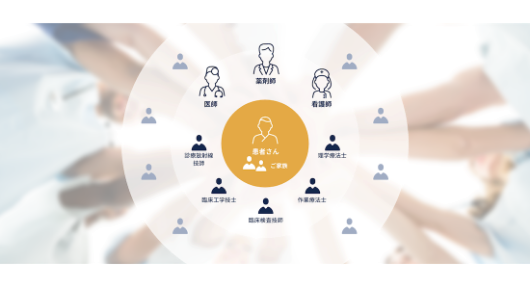
医療の現場で「チーム医療」が欠かせないいま、医師・看護師・薬剤師をはじめ多様な専門職との密な連携が強く求められています。
医療系総合大学である大阪医科薬科大学は、6年間(看護学部は4年間)を通じて多職種を理解し、実践的な連携ができる能力を養う多職種連携教育[IPE:Interprofessional Education]を推進しています。卒後、臨床現場や地域医療の現場で密な信頼関係を築くため、高度な知識と技術を修得します。
※掲載情報は2021年作成時のものです。
多職種連携教育推進のねらい
本学は医薬看による多職種連携教育への進化発展に力を入れています。医療現場では、「医師が患者の顔よりもモニター上のカルテを見ている」「30分も待って治療は3分」などの批判があります。こうした問題は、医師が患者さんの“病気”を診ようとするあまり、“人”としての患者さんを見ていないことに起因するものだと考えます。たとえば、同じ病気の患者さんでも、きちんと服薬したほうが良い人もいれば、運動や食事療法が合う人もいます。私たちが目指すのは、患者さんを“人”として診る、全人的な医療教育ができる大学です。高齢化が進む、本学の所在地・高槻市の状況を鑑みても、一人ひとりの患者さんに合わせた医療を提供できる体制を整えることは喫緊の課題と言えるでしょう。本学では、患者さんを中心において、医師、看護師、薬剤師、そしてさまざまな医療職が対等な立場で連携し、それぞれの人に必要な治療を提供する、真のチーム医療の実現に寄与する教育を推進していきます。
低〜中学年 多職種の理解を深める講義・演習
まずは「医療職にはどんな職種があり、各職種の人はどんなことを考えているのか」を正しく知り、信頼関係を築くことが多職種連携の第一歩です。入学直後の医薬看合同の「新入生合同研修」を皮切りに、相互理解を深めます。
-
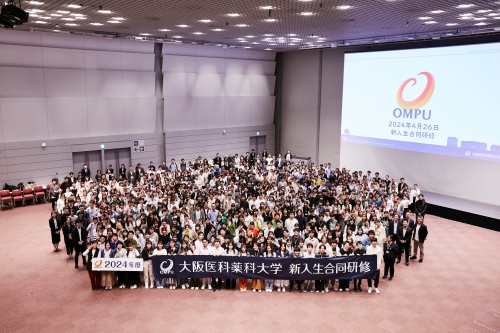
新入生合同研修 グランキューブ大阪にて、医・薬・看の3学部生が入り交じる研修を行い、ディスカッションを通じて、最初の交流を図ります。
-
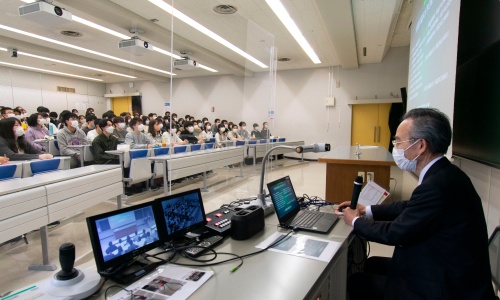
多職種連携論1「医療人マインド」 医学生・薬学生・看護学生でグループを編成し、一堂に会して講義を受講。同じ課題を多面的に理解します。
-
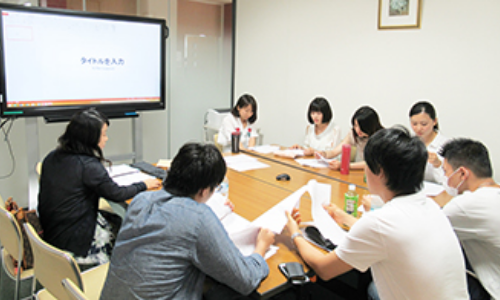
多職種連携論2「医療と専門職」 グループディスカッション形式で、専門職種と共同できる基礎的能力を身につけます。
中〜高学年 臨床・臨地実習と臨床カンファレンス
高知県地域医療支援プロジェクトでは、医看薬それぞれの学部から2名ずつが参加する合同選抜チームが、高知県本山町の嶺北中央病院を拠点に、地域医療の実習を行います。
地域包括ケアシステムのもと、医療・介護・福祉の実情を肌で感じられるプログラムです。医・看・薬それぞれの専門性を背景に、職種間のコミュニケーションと相互理解に基づく実践的な学びを深めます。
-
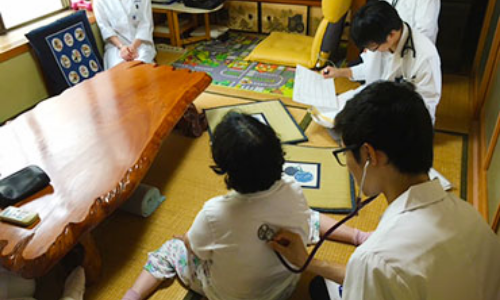
訪問診療風景 -
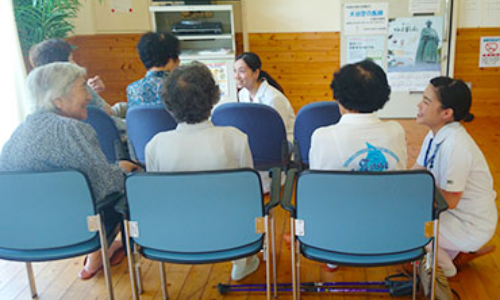
現地実習風景
中〜高学年 シミュレーション教育法を利用した実践型演習
医療倫理や医療安全など、高度な専門知識に基づく連携をしなければ解決できない課題に対し、PBLD(課題解決型授業)の手法を軸とした、実践的なアクティブラーニングを行います。
-
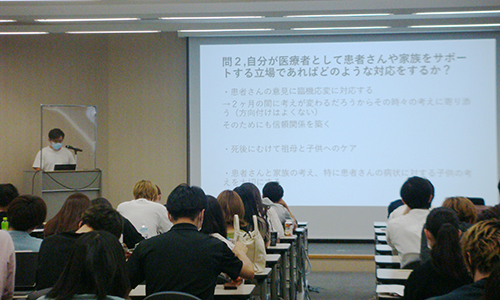
多職種連携論3『医療倫理』 生命・医療倫理問題に対し、他学部の視点を尊重し、最適な対応を提示できる能力を養います。
-
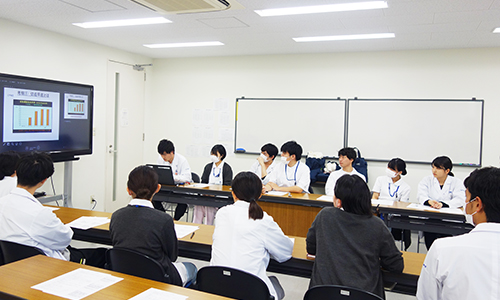
多職種連携論4『医療安全』 多職種連携論4(医療安全)では臨床現場において多職種視点が必要な医療安全シナリオについて検討します。
シミュレーション教育法とは?
現在の医学教育では、医学生や研修医は患者さんの生体を傷つけるような侵襲的な行為を行うことは倫理的に許容されていません。また、医薬看合同での臨床研修を行うときは人数が多くなるため空間的な制約も生じます。このため、テクニカルスキルからコミュニケーションに至るまで、シミュレーションを用いて学ぶことが非常に有効です。たとえば、臨床における重篤な事故事例や危機的事例のシナリオを PBL(Project Based Learning)の形式で提示。事前学習で基礎知識の獲得や学習目標の共有を行ったのちに、自他の職種の観点からの課題を抽出してチームでの連携をディスカッションします。シミュレーション後には、振り返りによって改善点を洗い出しさらに学びを深めています。
本学では、2017年度より「シミュレーション環境を活用した多職種連携教育システムの構築」を研究拠点育成奨励助成テーマとして採択。多職種連携教育とシミュレーション教育法に関する講演会を開くなど、医薬看の教員が合同で教育研究を進めてきました。さらに、2019年度の研究拠点育成助成テーマには「シームレスな多職種連携教育のための教員FDの構築」を採択。2020年には、多くの教員参加のもとで書籍『実践 多職種連携教育』も出版するなど、その知見を広く発信することにも取り組んでいます。
受講した学生の声
5年次の臨床合同カンファレンスでは、同じ患者さんを同時に担当しながらも、学部によって関わり方が全然違うことに驚きました。私は文化系のクラブにだけ所属していたこともあり、授業以外では他学部との関わりは少なく、視点が限られてしまってもったいないなと感じていました。医師は、患者さんと接するだけでなく、診療所外で他の職種の方々と関わることが多くあると思います。医師だけでやれることには限りがあり、他の職種を頼りにしています。多職種連携の授業で学んだことは、全然違う立場の人との「人間の関わり」です。視野が広がり、他の職種の人と「こうやって話せば良い」とわかったことは、研修医になったとき、生きてくると思います。
【医学部6回生 M.Oさん】
1年次の学外合宿に始まり、医療人マインド、専門職連携医療論という一連の授業を受けてきました。隣に座る他学部の学生さんとディスカッションする中で、「どういう学びをしてきて、どのような精神を持っているのか」を知ることができました。職種が違っても、根底として患者さんに向き合う姿勢は同じだと思います。ただ、それを医学部の中だけで学んでいると、他の人がどう考えているのかはわからない。医療のなかで身近な存在である看護学部生・薬学部生と関わる機会が、より多く授業に組み込まれるのは貴重です。多職種との垣根を低くして、互いに尊敬し合う関係づくりが大切だと思います。
【医学部4回生 S.Oさん】
1年次の医学部との合同合宿で、医学部と看護学部の視点や、考え方の違いについて学べたことが、後の看護学の授業でも活用できました。3年次の医看融合カンファレンスでは、母性看護学や精神看護学を選択し、より深く患者さんへの関わり方の違いなどに気付け、4年の臨床合同カンファレンスでは、それまで学んだことを改めて学び直す機会となりました。また、運動系クラブのマネージャーをしていたので、クラブ合宿の時などに自主的に医学部との勉強会も行えてたのが良かったです。今後、合同授業で薬学部生と直接ディスカッションできる機会が増えることは、臨床現場での患者さんへの接し方について、より広い視野で学んでいく為にも大切な要素だと思います。
【看護学部4回生 N.Bさん】
連携した学びがあるのを知って大学を決めました。1年次の合同合宿では医学部の方の知識量に驚くこともありましたが、それぞれの良い点に気付けたことで、看護の視点から「こうなりたい」という夢を持ってその後の学びを深めていくことができました。3年次の医学部との合同授業では、医師と今後の患者さんへの治療方針などをどうう伝えるか、というコミュニケーションの方法も学べました。様々な職業の視点や考え方の違いに気づく大切さを感じ、これからの在宅医療のことも考え、保健師になる為の学習も並行して続けています。今後は薬学部との連携が増え、横の学びもできることで、患者さんの疾患と処方する薬の関係性をより早い段階で学べるのは大切なことだと思いました。
【看護学部4回生 T.Mさん】
